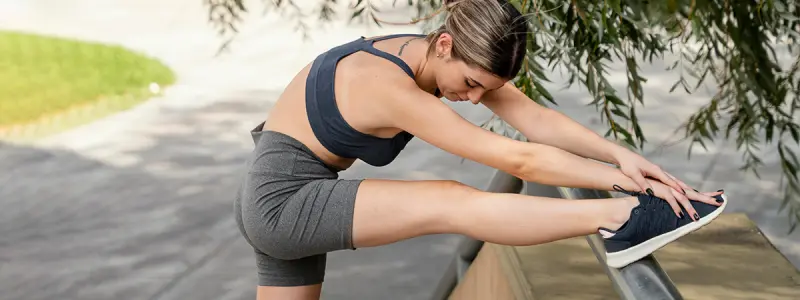Numbness is a common problem that many female cyclists face. It can affect the genital area, the buttocks, the thighs, or the feet. It can also affect your performance and enjoyment of cycling.
Cycling may cause numbness, uncomfortable pain, reduced sensations, and even sexual dysfunction in the pelvic area due to persistently high pressure. The blood flow can be reduced if the saddle is too narrow, soft, or unsuitable for the perineum’s nerves, fibers, and vessels.
We’ll explore the causes and effects of this issue and provide some helpful tips on how female cyclists can prevent and treat numbness to enhance their overall comfort and health.
Female Numbness After Cycling: 5 Bike Fit Errors to Fix

When addressing the issue of numbness after cycling, understanding the factors contributing to this discomfort is crucial. Let’s delve into the various aspects that can play a role in female numbness after cycling.
Bike Fit and Saddle Shape
Proper bike fit is crucial for comfortable cycling. A bike that is too big or too small can cause pressure on sensitive areas. Saddle shape and positioning also play a significant role in avoiding numbness. Women and men have different anatomical structures that require different saddle shapes. Here are some tips for finding the right fit:
- Importance of proper bike fit: Your bike should match your body size, shape, and proportions, allowing you to reach the pedals, handlebars, and brakes comfortably.
- Saddle shape and its impact on numbness: The shape of your saddle can influence how your weight is distributed on the seat, how much contact you have with the saddle, and how much pressure you feel on your genital area.
- The difference between men’s and women’s saddles: Women have wider sit bones and a shorter perineum length than men. Therefore, women’s saddles should be more expansive and have a cut-out or a groove in the middle to reduce pressure on soft tissues and nerves. Men’s saddles typically have a longer nose and are narrower.
Riding position
Your position on the bike affects your weight distribution, muscle tension, and blood flow. A poor posture puts pressure on sensitive areas and reduces sensations in your genitals. Here are some tips for maintaining a good riding position:
How Improper Position Can Cause Numbness
If you ride with a poor posture, you may put too much pressure on your hands, wrists, elbows, shoulders, neck, back, or hips. This can affect your blood circulation, nerve function, and muscle tension, leading to numbness.
Importance of Maintaining A Good Position While Cycling
Keep your back straight, your shoulders relaxed, and your elbows slightly bent. This can help you breathe better and avoid stiffness, pain, and numbness in your upper body. Adjust your seat angle and handlebar height to suit your riding style and terrain.
Clothing and Gear
Appropriate clothing and gear can help reduce pressure points, chafing, and irritation in sensitive areas. Outfits designed explicitly for cycling provide a comfortable fit that eliminates rubbing that can cause numbness and discomfort. Here are some tips for choosing the proper clothing and gear:
The Role of Clothing In Preventing Numbness
Wearing cycling shorts or pants made of breathable, moisture-wicking, smooth fabric can help prevent chafing, sweating, and irritation. Cycling shoes with a stiff sole can transfer power to the pedals, reducing numbness in the feet.
The Importance of Proper Gear For Cycling
Wearing gloves with enough padding can reduce numbness and maintain a solid grip throughout the ride. Using a helmet with a visor can shield your eyes from the sun, wind, and dust, keeping your head steady and reducing neck strain. Using a menstrual cup, a sponge, or a reusable cloth pad rather than underwear or tampons during menstruation can prevent rubbing and infection.
Left Foot Goes Numb When Cycling
Numbness in the left foot (or in both feet) can be attributed to poor circulation or nerve compression. This is often caused by ill-fitting cycling shoes or incorrect pedal position, which can restrict blood flow or undue pressure on nerves.
Vagina Numb After Cycling
Genital numbness is a concern many female cyclists experience but may feel hesitant to discuss. The primary cause is prolonged pressure from the saddle, which can compress nerve endings and restrict blood flow to the area.
Toes Numb Cycling
Numbness in the toes can result from several factors, including tight cycling shoes, poor cleat position, or excessive pressure on the forefoot. This sensation is a signal that your foot’s position or footwear needs to change.
Hands Go Numb Riding Bike
Hand numbness typically occurs because of pressure on the ulnar and median nerves, near the handlebars’ grip. An improper handlebar position or grip can lead to this uncomfortable sensation.
Women with Numbness After Cycling: Type of Effects
While it might initially feel like a minor discomfort, female numbness after cycling can significantly impact your cycling performance and health, we will delve deeper into the short-term and long-term effects of female numbness after cycling and why it’s essential to address the issue to prevent long-term damage.
Short-term Effects
Immediate Discomfort While Cycling

When the pelvic nerves that supply sensation to the genital area get compressed during cycling, women may feel numbness, tingling, or burning in the perineum. This can cause immediate discomfort while cycling, making it challenging to maintain your cycling performance.
Negative Impact on Performance
Female numbness after cycling can negatively impact your performance as you might constantly shift your position to ease the discomfort. This can increase friction and irritation, making it harder to pedal efficiently. Additionally,the reduction in sensation can impact your ability to transmit power to the pedals, making you less effective on the bike.
Long-term Effects
Potential Health Risks Associated with Prolonged Numbness
Prolonged female numbness after cycling can lead to several health risks, including:
Reduced Sexual Function
When you frequently cycle, your genital area undergoes repeated compression that can potentially damage the pelvic floor muscles and nerves. This can lead to reduced sexual arousal, pain during sexual intercourse, and even sexual dysfunction in some women.
Chronic Pain
Prolonged numbness can cause nerve damage, leading to chronic pain in the perineum, hips, and lower back. This can make engaging in regular physical activities challenging and diminish the quality of life.
Urinary Incontinence
Sustained compression on the pelvic nerves and muscles can lead to urinary incontinence, where you unintentionally leak urine. This can be extremely frustrating, leading to social isolation and embarrassment.
Long-term Damage Must be Prevented
Female numbness after cycling should not be ignored. The problem can lead to long-term effects impacting your performance and health. Here are a few ways to address the issue:
- Adjust your saddle height, angle, and position to reduce pressure on the perineum.
- Invest in high-quality bike shorts with proper padding and seams that reduce friction.
- Incorporate pelvic floor exercises in your workout routine to strengthen the muscles around the genital area.
- Take frequent breaks and stand up on the pedals to restore the blood flow in the perineum.
Genital Numbness, Tingling, or Pain
These symptoms can result from prolonged pressure on the genital area, especially when riding on a hard saddle without adequate padding. This pressure can compress the pudendal nerve and restrict blood flow, leading to numbness, tingling sensations, or pain in the genital region. Ensuring a properly fitted bike, adjusting the saddle angle and height, and using padded shorts can help mitigate these issues.
Menstrual Changes
Intense physical activity, such as long-distance cycling, might lead to changes in menstrual cycles. Some women may experience alterations in the frequency, duration, or intensity of their periods. In extreme cases, amenorrhea (the absence of menstruation) can occur, which is often linked to decreased body fat and high physical stress levels. Maintaining a balanced diet and managing training intensity can help in minimizing such side effects.
Numbness in Females After Cycling: Prevention Tips
Numbness can occur due to improper bike fit, insufficient stretching, and even the saddle used for cycling. We will discuss professional tips and tricks to prevent or reduce female numbness after cycling.
Proper Bike Fit and Saddle Adjustment
The first and most fundamental step to prevent numbness is ensuring your bike fits you correctly. Inadequate bike fit can cause pressure on the pelvic area, leading to numbness or pain. Here are some tips that can help you adjust your saddle and bike correctly:
Seek Professional Help for Bike Fitting
A professional bike fitting service can help you adjust your bike’s position and saddle height according to your body type. A professional should assess your riding position, saddle angle, and handlebar reach to achieve the right fit for you.
Proper Saddle Adjustment
A saddle should be parallel to the ground and positioned to support your sit bones. Tilting the saddle downward can cause pressure on your soft tissue, leading to numbness or pain. Adjust your saddle height, fore and aft, and angle for the best comfort.
Stretching and Strengthening Exercises
Stretching and strengthening exercises are essential to ensure your muscles and joints remain relaxed and well-aligned during cycling. It also helps prevent you from experiencing numbness in the pelvic area. Here are some activities that can aid in reducing numbness:
Pelvic Tilt Exercise
This exercise involves lying on the back, bending knees, and flattening the lower back to the floor. Doing this exercise makes your pelvic muscles more flexible and reduces numbness.
Kegels Exercise
Kegel’s exercise helps strengthen the pelvic floor muscles and increase blood flow to the pelvic area, decreasing numbness and pain.
Hip Flexor Stretches

A tight hip flexor can cause pain in the lower back and pelvis. Hence, stretching the hip flexors can help maintain a healthy cycling posture.
Alternative Saddle Options:
If your efforts to adjust your bike fit, saddle, and stretching do not work out for you, you may explore alternative saddle options. A bike saddle is crucial to reduce discomfort and frequent numbness for women. We recommend the following:
Cutout Saddle
A cutout saddle has a portion removed in the center where softer tissues of the pubic bone and labial folds can retreat. This design helps to reduce pressure in the soft tissues, thus minimizing numbness.
Wide Saddle
A saddle with a broader base than the typical racing saddle distributes pressure to a larger area, backing your sit bones, thus preventing pain and numbness.
Saddle with Springs
A saddle with springs attached can reduce road vibration through the harness, which helps to reduce discomfort in soft tissues.
Conclusion
The purpose of this blog post is to shed some light on the issue of female numbness following cycling and to help female cyclists better understand the causes of this discomfort. Following the tips and recommendations outlined here, we believe female cyclists can reduce or eliminate numbness, greatly enhancing their overall cycling experience.
Addressing this issue cannot be overstated, as it improves comfort and performance and helps prevent potential long-term health risks. So, let’s prioritize our comfort and health on the bike and ride confidently, knowing we’re taking care of ourselves.
FAQs
How Do I Protect My Prostate When Cycling?
The irritation of the prostate caused by bicycle riding, in combination with the aging process, can cause moderate to severe discomfort. A male-specific bike seat, tilting your seat slightly forward, and standing on the pedals once every 15 minutes can help prevent cycling-related prostatitis.
Why Do My Feet Go Numb On The Stationary Bike?
Pedaling causes the foot to tire and lose its natural arched shape, compressing the metatarsophalangeal joints further. Nerve branches and blood vessels constrict, causing the toes to tingle or become numb.
Does Cycling Cause Perineal Numbness?
A saddle without a cut-out can potentially alleviate perineal numbness. Additionally, wide and padded saddles, along with cushioned biking shorts, provide enhanced comfort and better safeguard the perineal soft tissue compared to alternative seat designs.
What Does A Cyclist Do to Protect Her Lady Parts?
To prevent friction around seams or otherwise, wear snug bottoms or underwear. I recommend going without underwear unless your specific anatomy requires it. The chamois pad in bike and triathlon shorts prevents chafing.


